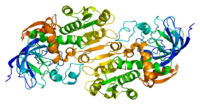
Photo from wikipedia
Escherichia coli was metabolically engineered to effectively produce a series of biopolymers consisted of four types of monomers including glycolate, lactate, 3-hydroxybutyrate and 4-hydroxybutyrate from glucose as the carbon source.… Click to show full abstract
Escherichia coli was metabolically engineered to effectively produce a series of biopolymers consisted of four types of monomers including glycolate, lactate, 3-hydroxybutyrate and 4-hydroxybutyrate from glucose as the carbon source. The biosynthetic route of novel quadripolymers was achieved by the overexpression of a range of homologous and heterologous enzymes including isocitrate lyase, isocitrate dehydrogenase kinase/phosphatase, glyoxylate/hydroxypyruvate reductase, propionyl-CoA transferase, β-ketothiolase, acetoacetyl-CoA reductase, succinate semialdehyde dehydrogenase, 4-hydroxybutyrate dehydrogenase, CoA transferase and PHA synthase. In shake flask cultures using Luria-Bertani medium supplemented with glucose, the recombinant E. coli reached 7.10g/l cell dry weight with 52.60wt% biopolymer content. In bioreactor study, the final cell dry weight was 19.61g/l, containing 14.29g/l biopolymer. The structure of the produced polymer was chemically characterized by proton NMR analysis. Assessment of thermal and mechanical properties demonstrated that the quadripolymer possessed decreased crystallinity and improved toughness, in comparison to poly-3-hydroxybutyrate homopolymer. This is the first study reporting efficient microbial production of the quadripolymer poly(glycolate-co-lactate-co-3-hydroxybutyrate-co-4-hydroxybutyrate) from glucose.
Journal Title: Metabolic engineering
Year Published: 2017
Link to full text (if available)
Share on Social Media: Sign Up to like & get
recommendations!